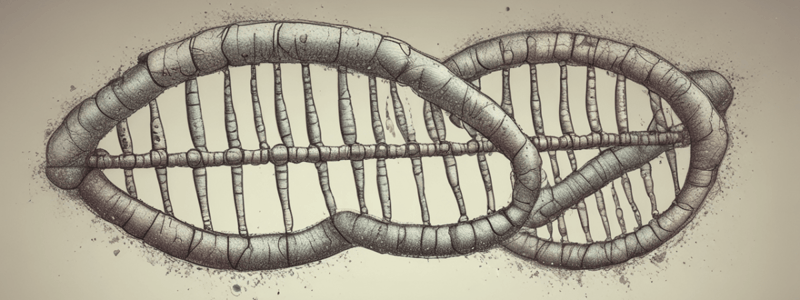Podcast
Questions and Answers
How many chromosomes do human beings typically have, including autosomal and sex chromosomes?
How many chromosomes do human beings typically have, including autosomal and sex chromosomes?
- 24 chromosomes
- 46 chromosomes (correct)
- 50 chromosomes
- 48 chromosomes
Which nucleotide is unique to DNA and absent in RNA?
Which nucleotide is unique to DNA and absent in RNA?
- Thymine (T) (correct)
- Uracil (U)
- Adenine (A)
- Cytosine (C)
In the context of genetic makeup, what does the term 'genotype' specifically refer to?
In the context of genetic makeup, what does the term 'genotype' specifically refer to?
- Physical characteristics
- Inheritance patterns
- Behavioral traits
- Genetic composition (correct)
Which type of mutation involves changes in the number or structure of chromosomes?
Which type of mutation involves changes in the number or structure of chromosomes?
What determines an individual's physical and behavioral characteristics?
What determines an individual's physical and behavioral characteristics?
What distinguishes complex inheritance from simple Mendelian traits?
What distinguishes complex inheritance from simple Mendelian traits?
Which of the following best describes an allele?
Which of the following best describes an allele?
What structural elements can be found in functional genes?
What structural elements can be found in functional genes?
In genetics, what is the term used for the location of a gene?
In genetics, what is the term used for the location of a gene?
Which type of traits are influenced by multiple genes and environmental factors?
Which type of traits are influenced by multiple genes and environmental factors?
What type of genetic material encodes information to make proteins?
What type of genetic material encodes information to make proteins?
Flashcards are hidden until you start studying
Study Notes
Genetics: Understanding the Complexities of Inheritance, Alleles, Chromosomes, and Nucleic Acid Structure
Genetics is the study of heredity and the variation of inherited traits within and between species. Over the years, genetics has evolved from the simple understanding of Mendelian inheritance to a more complex and nuanced field. In this article, we will explore the subtopics of complex inheritance, allele versus mutation, chromosome number, nucleic acid structure, and genotype versus phenotype.
Complex Inheritance
Complex inheritance refers to traits that result from the interaction between multiple genes and their environment. Unlike simple traits that follow Mendel's laws of inheritance, complex traits exhibit inconsistent patterns of inheritance across generations. For example, a dominant trait might be skipped in one generation but expressed in the next. This inconsistency in inheritance patterns is due to the influence of multiple genes and environmental factors on the expression of the trait. Complex traits are common in humans and include many diseases and traits, such as height, hair color, and susceptibility to certain diseases.
Allele vs. Mutation
An allele is a version of a gene that is inherited from each parent. Most functional genes encode information within exons, separated by introns, to make proteins. Each gene has an upstream enhancer and promoter sequence as well as a terminal stop sequence. The location of a gene is called the gene locus. Most functional genes encode information within exons, separated by introns, to make proteins.
A mutation is a change in the DNA sequence. Mutations can occur spontaneously or be induced by environmental factors. They can be classified into three types: point mutations, insertions/deletions, and chromosomal aberrations. Point mutations involve a change in a single nucleotide, while insertions/deletions involve the addition or removal of one or more nucleotides. Chromosomal aberrations involve changes in the number or structure of chromosomes. Mutations can have various effects on phenotype, from causing subtle differences to severe effects.
Chromosome Number
Human beings have 46 chromosomes, including 22 pairs of autosomal chromosomes (named according to their size, 1 being largest and 22 the smallest) and 2 sex chromosomes (X and Y for males, and 2 X for females). Chromosomes are the physical carriers of genetic information, and their number and structure play a crucial role in determining an organism's phenotype.
Nucleic Acid Structure
Nucleic acids, particularly DNA and RNA, are the molecules that store and transmit genetic information. DNA is a double-stranded molecule composed of a sugar called deoxyribose, a phosphate group, and four nitrogenous bases: adenine (A), cytosine (C), guanine (G), and thymine (T) in humans. RNA is a single-stranded molecule with the same structure as DNA, but with the sugar ribose instead of deoxyribose. The structure of nucleic acids is crucial for their function, as it determines how the genetic information is stored, transcribed, and translated.
Genotype vs. Phenotype
Genotype refers to the genetic makeup of an individual, while phenotype refers to the physical and behavioral characteristics of an individual. A person's appearance or phenotype is determined by their genotype, which in turn determines their susceptibility to certain diseases and disorders. For example, monozygotic twins share a common genotype but can exhibit phenotypic differences due to epigenetic modifications.
In conclusion, genetics is a complex field that involves the study of inheritance, alleles, mutations, chromosomes, and nucleic acid structure. Understanding these concepts is essential for understanding the genetic basis of various diseases, disorders, and traits in humans and other species.
Studying That Suits You
Use AI to generate personalized quizzes and flashcards to suit your learning preferences.




